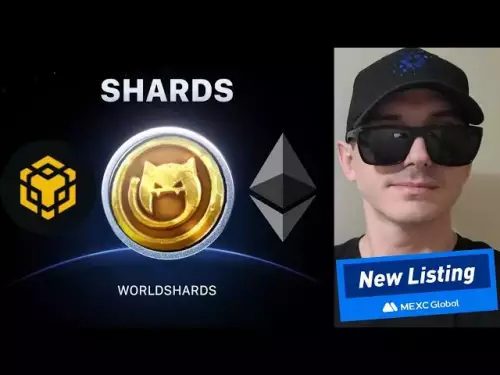-
 Bitcoin
Bitcoin $109400
-2.31% -
 Ethereum
Ethereum $4290
-3.89% -
 Tether USDt
Tether USDt $1.000
-0.05% -
 XRP
XRP $2.809
-2.01% -
 BNB
BNB $844.5
-1.76% -
 Solana
Solana $203.8
-3.20% -
 USDC
USDC $0.9998
-0.06% -
 Dogecoin
Dogecoin $0.2123
-2.84% -
 TRON
TRON $0.3353
-1.67% -
 Cardano
Cardano $0.8089
-3.75% -
 Chainlink
Chainlink $22.45
-5.67% -
 Hyperliquid
Hyperliquid $45.06
-1.97% -
 Ethena USDe
Ethena USDe $1.001
0.00% -
 Bitcoin Cash
Bitcoin Cash $587.3
-0.66% -
 Sui
Sui $3.259
-3.62% -
 Stellar
Stellar $0.3541
-3.04% -
 Avalanche
Avalanche $24.67
-2.69% -
 Hedera
Hedera $0.2120
-4.20% -
 Cronos
Cronos $0.2662
-4.78% -
 UNUS SED LEO
UNUS SED LEO $9.524
0.04% -
 Litecoin
Litecoin $109.8
-2.77% -
 Toncoin
Toncoin $3.103
-2.44% -
 Shiba Inu
Shiba Inu $0.00001208
-3.49% -
 Polkadot
Polkadot $3.762
-3.09% -
 Uniswap
Uniswap $9.191
-5.38% -
 Dai
Dai $0.9998
-0.01% -
 Monero
Monero $269.0
-0.03% -
 Aave
Aave $308.5
-5.38% -
 Bitget Token
Bitget Token $4.841
-3.27% -
 Ethena
Ethena $0.6643
-8.80%
What is a rage quit mechanism in a DAO?
A rage quit lets DAO members exit and reclaim their treasury share if they oppose a passed proposal, enhancing governance accountability and trust.
Sep 04, 2025 at 04:00 pm
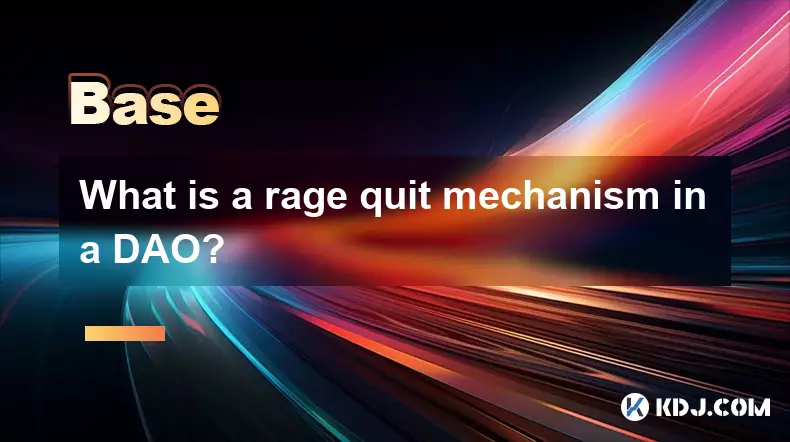
Understanding the Rage Quit Mechanism in DAOs
1. A rage quit mechanism allows members of a decentralized autonomous organization (DAO) to exit the organization and reclaim their share of the treasury if they disagree with a governance decision. This feature is embedded in the smart contract code and activates under specific conditions, typically after a voting period concludes.
2. The mechanism is designed to protect individual stakeholders from being forced to remain in a DAO whose direction they no longer support. It promotes accountability by giving members a tangible way to express dissent beyond just voting.
3. When a proposal passes that a member opposes, they have a defined window—often 3 to 7 days—to initiate a rage quit. During this time, they can withdraw their proportional share of the DAO’s assets based on their token holdings at the time of the vote.
4. The process relies on on-chain verification of voting records and token balances. Once triggered, the smart contract calculates the member’s entitled funds and transfers them automatically, ensuring transparency and eliminating the need for intermediaries.
5. This functionality strengthens trust in DAO governance by reducing the risk of capital lock-in. Members know they retain an exit option if collective decisions move against their interests, which encourages more active participation in voting.
Technical Implementation of Rage Quit
1. The rage quit function is coded into the DAO’s governance contract, often using frameworks like MolochDAO or Aragon. It checks whether a member voted against a passed proposal and confirms their eligibility to withdraw.
2. Upon execution, the system references the member’s token balance at the time of the vote snapshot, not the current balance. This prevents last-minute token dumping or manipulation before quitting.
3. Funds are distributed proportionally from the DAO’s treasury, excluding assets that are locked in long-term investments or smart contracts that don’t allow immediate withdrawal.
4. The withdrawal is typically limited to native tokens or stablecoins held in the treasury. Illiquid or non-fungible assets may require separate handling or may not be accessible through the rage quit.
5. Gas costs for executing the rage quit are borne by the user, which can be a deterrent during periods of high network congestion or elevated transaction fees on Ethereum or other blockchains.
Impact on DAO Governance and Behavior
1. The presence of a rage quit option influences how members vote. Knowing they can exit with funds if outvoted, participants may feel more confident in casting honest votes, even if they expect to be in the minority.
2. It discourages coercive governance tactics, such as rushing proposals or manipulating voter turnout, because members retain a financial exit right. This fosters a more equitable decision-making environment.
3. DAOs with rage quit mechanisms often see higher voter engagement, as members understand their economic exposure is actively managed by the system’s rules, not just social consensus.
4. Frequent rage quits can signal internal conflict or misalignment in vision. A sudden wave of exits after a proposal may prompt leadership to reevaluate strategy or communication.
5. The mechanism reinforces the principle of exit over voice in decentralized systems, where the ability to leave with one’s capital serves as a check on centralized control.
Challenges and Limitations
1. Rage quits can destabilize a DAO’s treasury if many members exit simultaneously, especially if the treasury lacks sufficient liquid assets to cover withdrawals.
2. The time window for quitting is critical. Too short, and members may miss the opportunity; too long, and it delays the DAO’s ability to execute decisions with confidence in its capital base.
3. Some critics argue that rage quits encourage short-term thinking, as members might prioritize immediate financial extraction over long-term community health.
4. Smart contract vulnerabilities could be exploited during the rage quit process, such as reentrancy attacks or incorrect balance calculations, leading to fund loss.
5. Not all DAOs implement rage quits. Some prefer social coordination or gradual exit mechanisms like token sales, viewing rage quits as too disruptive for sustainable governance.
Frequently Asked Questions
What happens to a member’s voting rights after a rage quit?Once a member executes a rage quit, they forfeit all future voting rights in the DAO. Their tokens are effectively burned or removed from the voting ledger, and they are no longer part of the governance structure.
Can a rage quit be reversed?No, a rage quit is irreversible. The transaction is final and executed on-chain. Once funds are withdrawn and tokens are invalidated, the member cannot rejoin with the same stake unless they acquire new tokens through purchase or allocation.
Are all DAOs required to have a rage quit mechanism?No, the rage quit is optional and depends on the DAO’s design. It originated in MolochDAO-inspired structures but is not a universal feature. Many DAOs opt for alternative governance safeguards.
Does a rage quit affect the value of remaining members’ shares?Yes, when a member rage quits, the total treasury decreases, but the remaining token supply may stay the same unless tokens are burned. This can dilute the per-token value if the treasury shrinks significantly relative to the outstanding supply.
Disclaimer:info@kdj.com
The information provided is not trading advice. kdj.com does not assume any responsibility for any investments made based on the information provided in this article. Cryptocurrencies are highly volatile and it is highly recommended that you invest with caution after thorough research!
If you believe that the content used on this website infringes your copyright, please contact us immediately (info@kdj.com) and we will delete it promptly.
- Dogecoin, Forecast, and Meme Coins: Navigating the Hype in '25
- 2025-09-05 00:25:12
- Anchorage, Starknet, and Crypto Yield: A New Era for Institutional Staking
- 2025-09-04 22:45:13
- Dogecoin's Key Indicator Flashes Buy Signal Amidst Market Drop: A New York Minute
- 2025-09-04 22:25:15
- Gold, Trump, and the Flight to Safety: What's Driving the Market in 2025?
- 2025-09-04 22:25:15
- Cryptos to Watch: BlockchainFX ($BFX) Surges Ahead, Leaving Tron Market Share in the Dust
- 2025-09-04 23:25:12
- Sui, Bitcoin, and Upgrades: Decoding the Crypto Trends
- 2025-09-04 23:45:11
Related knowledge

What is "backtesting" a crypto trading strategy?
Sep 03,2025 at 10:55am
Understanding Backtesting in Crypto TradingBacktesting is the process of evaluating a trading strategy by applying it to historical market data. Trade...

What is a "crypto trading bot" and do they work?
Sep 02,2025 at 04:19pm
Understanding Crypto Trading Bots1. A crypto trading bot is a software application designed to automate the process of buying and selling cryptocurren...

What is a "copy trading" platform?
Sep 02,2025 at 07:00pm
Understanding Copy Trading in the Cryptocurrency Space1. A copy trading platform allows users to automatically replicate the trades of experienced inv...
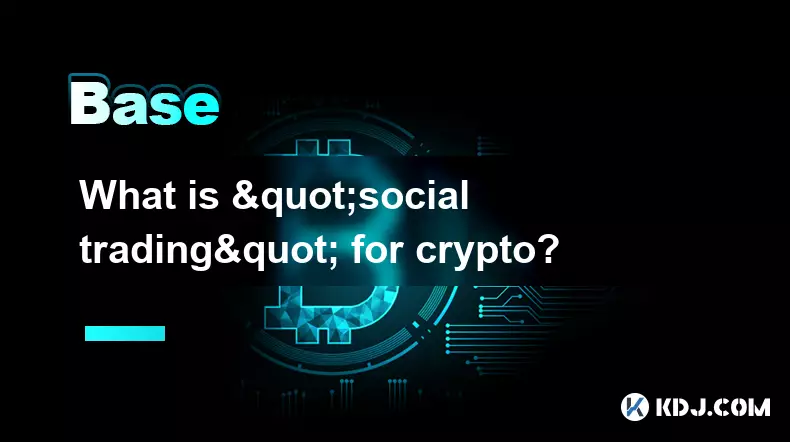
What is "social trading" for crypto?
Sep 03,2025 at 09:00pm
Understanding Social Trading in the Cryptocurrency Space1. Social trading refers to a method where investors observe, follow, and automatically replic...
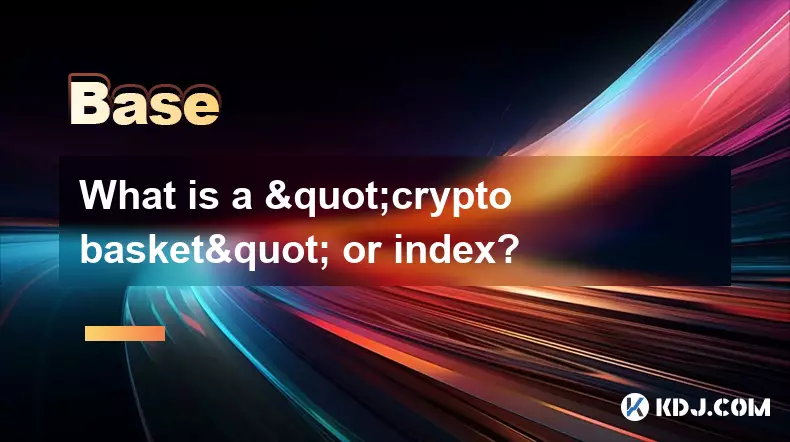
What is a "crypto basket" or index?
Sep 03,2025 at 07:01am
Understanding Crypto Baskets and Their Role in Digital Asset Investment1. A crypto basket refers to a curated collection of multiple cryptocurrencies ...
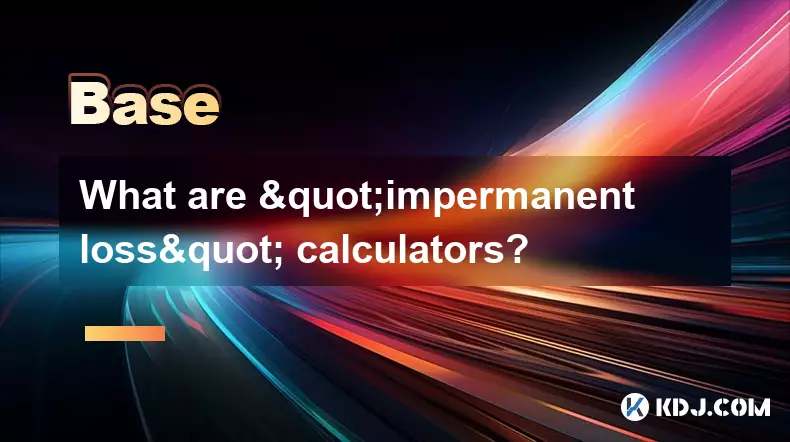
What are "impermanent loss" calculators?
Sep 03,2025 at 12:00pm
Understanding Impermanent Loss in Decentralized Finance1. Impermanent loss is a phenomenon that affects liquidity providers in decentralized exchanges...

What is "backtesting" a crypto trading strategy?
Sep 03,2025 at 10:55am
Understanding Backtesting in Crypto TradingBacktesting is the process of evaluating a trading strategy by applying it to historical market data. Trade...

What is a "crypto trading bot" and do they work?
Sep 02,2025 at 04:19pm
Understanding Crypto Trading Bots1. A crypto trading bot is a software application designed to automate the process of buying and selling cryptocurren...

What is a "copy trading" platform?
Sep 02,2025 at 07:00pm
Understanding Copy Trading in the Cryptocurrency Space1. A copy trading platform allows users to automatically replicate the trades of experienced inv...

What is "social trading" for crypto?
Sep 03,2025 at 09:00pm
Understanding Social Trading in the Cryptocurrency Space1. Social trading refers to a method where investors observe, follow, and automatically replic...

What is a "crypto basket" or index?
Sep 03,2025 at 07:01am
Understanding Crypto Baskets and Their Role in Digital Asset Investment1. A crypto basket refers to a curated collection of multiple cryptocurrencies ...

What are "impermanent loss" calculators?
Sep 03,2025 at 12:00pm
Understanding Impermanent Loss in Decentralized Finance1. Impermanent loss is a phenomenon that affects liquidity providers in decentralized exchanges...
See all articles























